/remixing_materials
(23_january_2022)
This first week of Exploring Emergent Technologies discussed the topic of biomaterials
though the course Remixing Mateirals. Lara Campos, an argentinian designer with an extensive
experience in creating and using biomaterials, was in charge of the workshop and during
this first session she gave us an introduction to the topic.
Lara started the session by introducing some of the projects she has been working on
these last years. Personally, I found very interesting 'Ceggmica', a project based on
creating materials from egg shells, and 'En(des)use', a project that consisted of designing
with biomaterials, giving them a use beyond experimentation.
On the other hand, Lara also highlighted the fact that materials communicate and provoke
feelings, emotions and sensations. It is relevant the way we interact with the material
itself and thinking of the way it is related to nature and culture. She showed us the
diagram on the right that explains materials in design.

Finally, she explained to us the basics of the composition of every biomaterial: a biopolymer,
a plasticizer, the additives and the solvent. Each of these components has different alternatives
one can use, that of course will give many diverse properties to the biomaterials we are cooking.
We also had the chance to touch and analyse some biomaterial samples Lara had brought and think of
some uses we could give them.
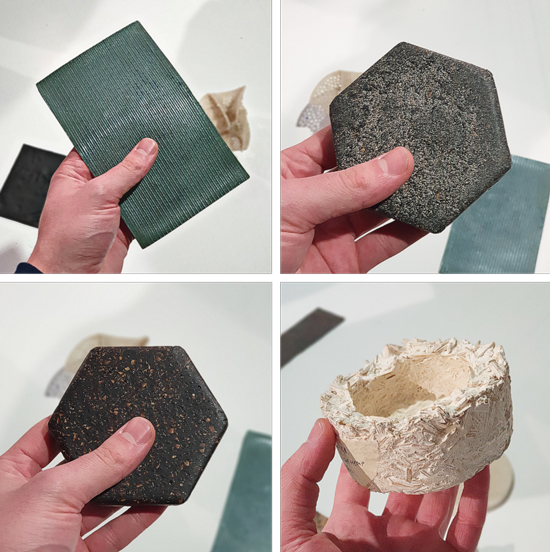
.workshop_on_biomaterials
(30_january_2022)
During this second session of Remixing Materials with Lara Campos, we had the chance to experiment
with different kinds of biomaterials using a wide diversity of food waste and colourants. Before
the workshop, we were told to collect our own food waste, dry it and grind it in order to be able
to use it for the biomaterials we were going to produce. In my case, I collected some sunflower
shells that I further ground to a small size.
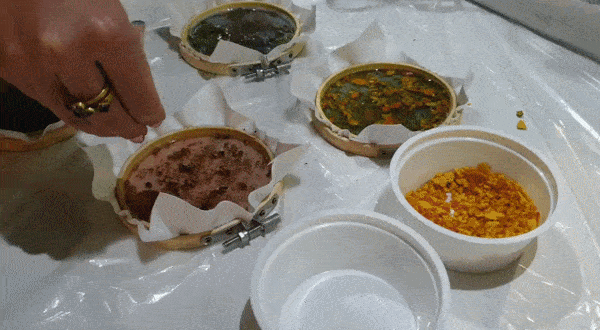
The first biomaterial we created was made out of gelatine. We used the recipe to cook them and some
circular shapes with the fabric below as a mould. We poured the mix into the mould and then started
adding all the other components: eggshells, orange peels, ground coffee, fern leaves, sunflower
shells, etcetera. We also used different colours of Mica as colourants that gave the biomaterial
an amazing glossy look. Once it dried, the piece we created became stronger but also jelly and gummy.
Also, since all the water evaporated, it became much thinner and the food waste gained in importance.
Later on, we created a biomaterial using alginate as the main composite. Again, we used a cooking
pot to join all the components together and then divides the resultant dense mix in two: the first
one, we used it the same way that the gelatine one and poured it into a circular shape with fabric;
the other half was used to create threads using a syringe and a pot filled with a calcium chloride
solution.
It was surprising seeing how the liquid became solid instantly when touching the solution
and created this weird texture such as a jellyfish. When dry, the thread became much thinner and also
rigid and fragile, quite the opposite than it was before.
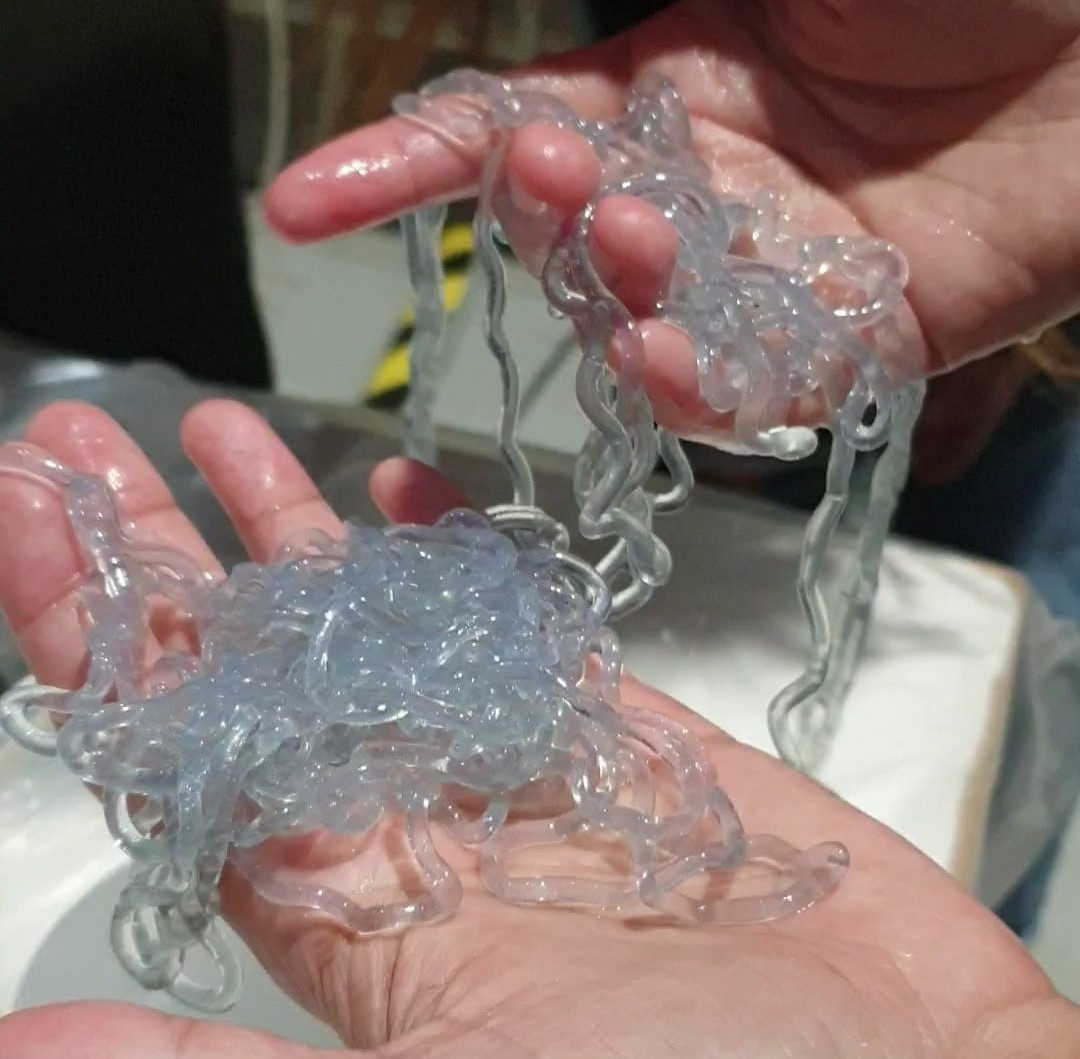
Finally, we used resin to create the last biomaterial. This recipe was a bit more tricky since resin
has very specific characteristics: it had to be solved in alcohol (not water), the mould needs to be
silicon or be covered with baking paper, and the cooking time is extremely important. Again, we used
our food waste and mixed it with the resin inside the cooking pot, then poured it into the mould. In
my case, I mixed the resin with the partially ground sunflower shells and ground coffee as a colourant.
Reflecting on this workshop, I think it has been a really instructive and interesting way to approach
the topic of biomaterials. As far as I am concerned, I had never worked with biomaterials before and
having the chance of getting to know this new subject has been a great experience that enables me to
further explore the opportunities of these biomaterials. I believe this is the main question now: What
can we do with that?
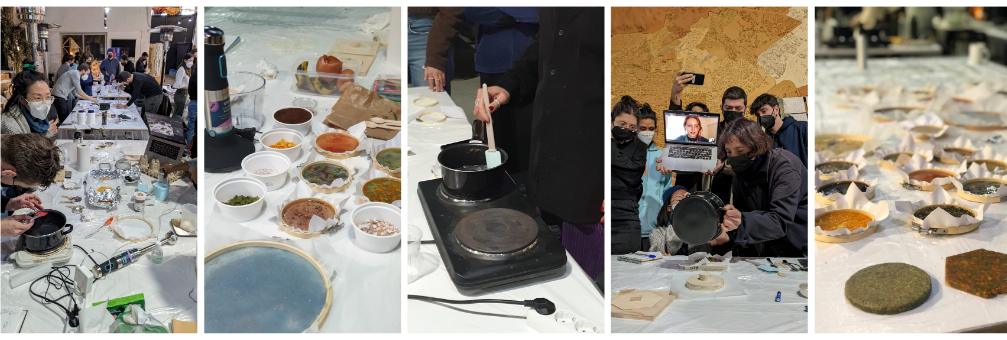
.further_explorations
Lara told us to keep exploring the possibilities and to try to go further, so I decided to create
an object out of biomaterial, not only a sample. The day we had the workshop I wanted to create
an ashtray out of a rigid biomaterial, probably resin. However, I didn't have enough time and material
to prepare it properly and it didn't work out well. So, I decided to develop a new ashtray from
scratch that I could reproduce as many times as I wanted.
I started thinking of an original shape for the ashtray and then 3D modelled it on SolidWorks,
taking into account that there weren't inaccessible parts nor right angles. Secondly, I sliced the
part and printed it on my 3D printer. After this, I used silicon to form the mould of the ashtray
that can be used with many different materials. Finally, I used the resin recipe doubled the
quantities and added some burnt wood and ashes to give it colour. This is the result of the
experiment:
.materials_in_context
(20_february_2022)
The following two sessions of Remixing Materials put the spotlight on Materials in Context, carried out
by Laura Freixas, MDEF alumni now working at Elisava Research. For this second part of the workshop,
we started looking for waste material opportunities around Poblenou and its surroundings. I teamed
up with Anna and Jeremy and detected some opportunities in the construction sector, the restaurant
industry, and also from the FabLab. Our experimentation interests generally focused on obsolete objects
from the trash that could be given a second life, so the opportunities selected could fit in that topic.
We finally decided to choose the material opportunity from FabLab, which was the waste from the 3D
printers: obsolete or broken 3D printed parts in PLA. PLA is considered a biomaterial since it's
made out of starch from corn in almost its totality. Currently, there are many initiatives that
transform this obsolete plastic into some other object because of its properties after melting it
again. The most famous one is Precious Plastic, where they created some DIY machines to process the
PLA parts: shredder, press, plastic injector, etc.

After this, we made a SWOT analysis for the material and also thought of the life cycle of it and
how to give it a second life. Then, we started the experimentation. For us, making all the processes
of transforming PLA parts into sheets was an unknown thing even though this is a commonly used
technique. However, since we hadn't explored this field before, it was quite fascinating to see the
results of shredding and then creating colourful sheets with an oven. The trickiest part without any
doubt was to define the settings for the oven in relation to the quantity of plastic, temperature
and time. We finally got to a pretty precise configuration that gave us strong and flat sheets:
- Silicon mould 20x25cm
- 220g of shredded plastic
- Oven at 200ºC up and down
- 10 to 15 minutes (always checking it)
The final step was to use those sheets we had in order to create new objects and products. For that,
we used the laser cutter of Ateneu de Fabricació del Parc Tecnològic to cut some designs we had
created. We also learnt how to laser cut a material that constantly melts: cutting fast and
decreasing the power and repeating twice or thrice. This is the final video from all the processes
we followed:
On the second day, every group exposed their materials and their explorations and was a good chance to get to know other possibilities of biomaterials created from waste from the neighbourhood. One of the projects I liked the most was Emilio's and Andrea's (and I don't remember if somebody else) where they used flowers from the cemetery to create a rigid material mixed with pine resin. I found it really poetic and at the same time an interesting field to explore since this is a constant waste in every cemetery and some work could be done.
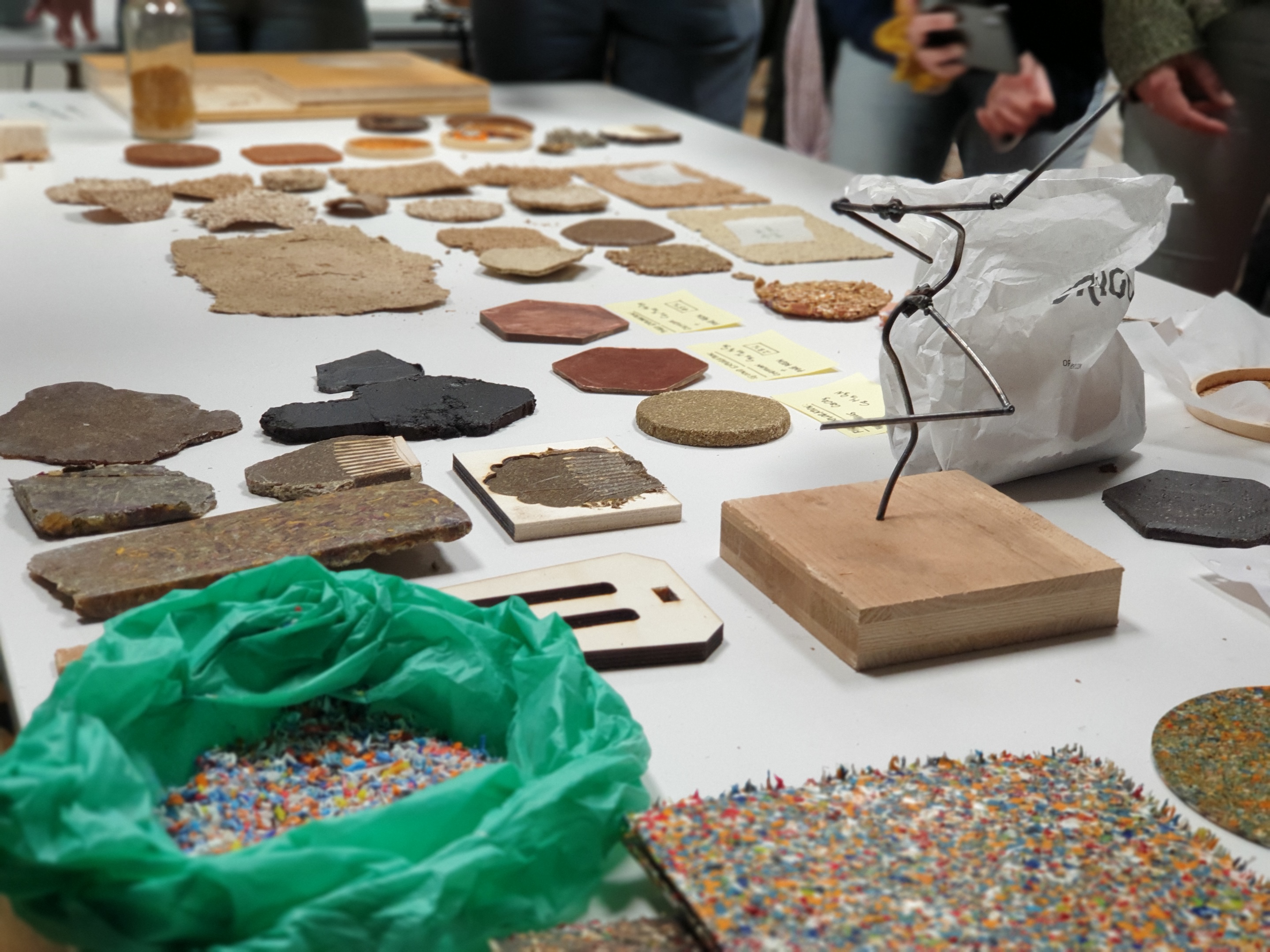
To sum up this second part of Remixing Materials with Laura Freixas, this is the final submission we had to upload, where one can see all the different steps of the process we followed to get to the final result of our biomaterial. From the exploration to the reflections: